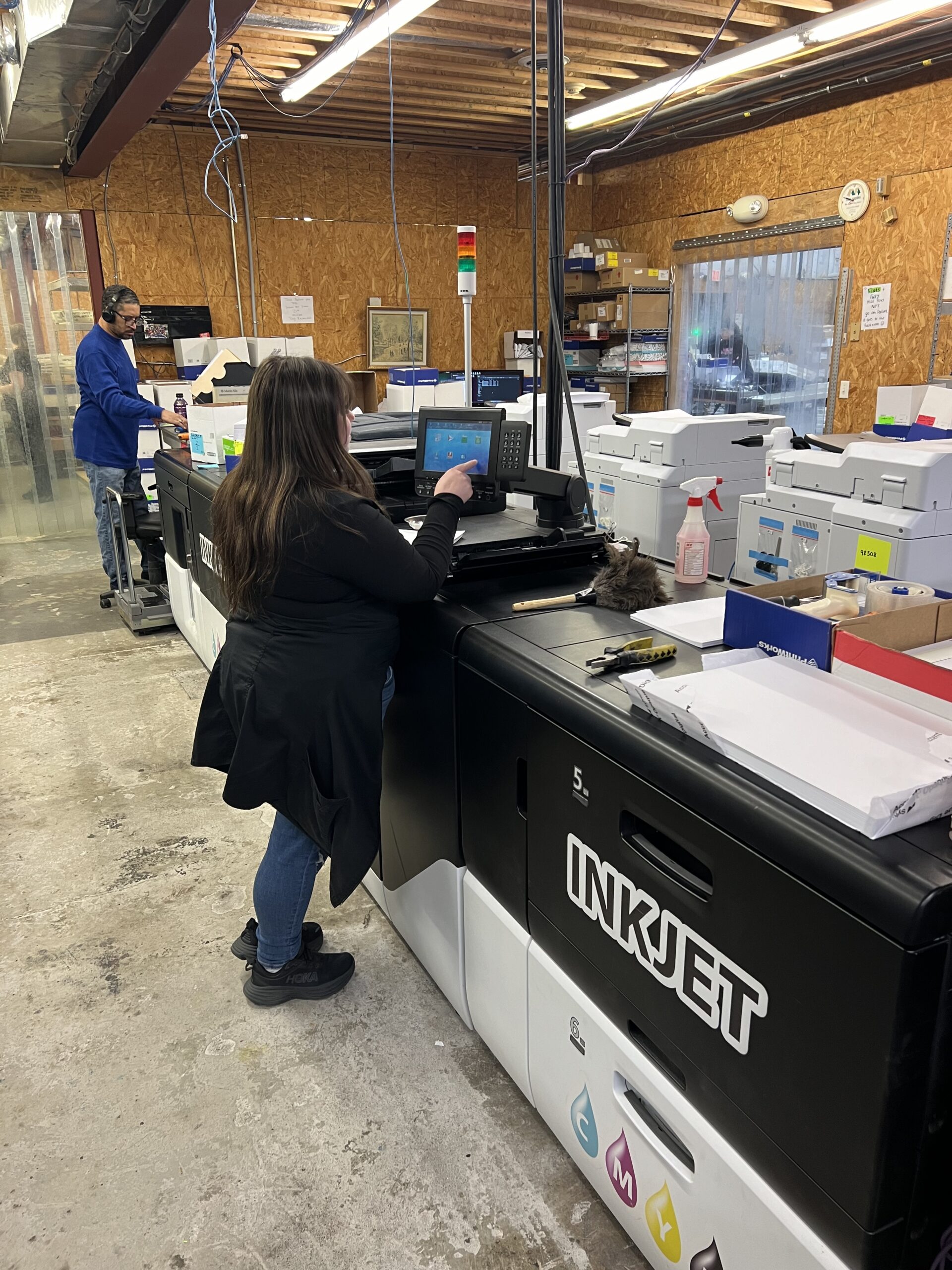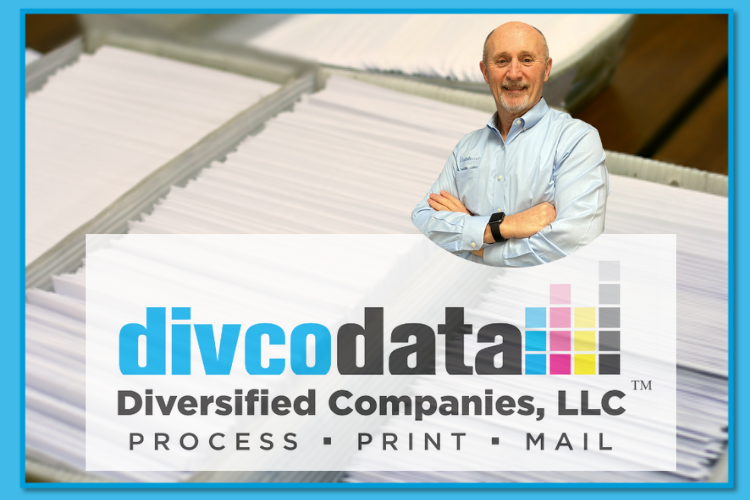John Dawson, Managing Director of DivcoData describes customer service as a “lost art.” However, he believes that the foundation of their company has always been customer service noting, “Our customers depend on us to get their work out on time.”
Founded in 1992 in Chattanooga Tennessee as small, commercial printer using offset to produce shells and sheetfed monochrome toner presses for overprinting, DivcoData has evolved into a very deadline-driven business – transaction printing. DivcoData started their evolution from commercial printing into variable data printing serving ministries and non-profits doing “ask letters.”
That transition accelerated after the worldwide financial crunch in 2008. Dawson recalls, “a lot of our business at that time was focused on the housing industry, and of course the housing bubble burst. We had one client that drove $2.5 million in revenue and by the time it was over they were at less than a million.”
“We had to find alternate routes, so we began the process to take a close look at the applications we served.” Since 2009, the company has rejuvenated their business with a focus on data-driven print for municipalities and utilities. “We now have about 650 clients across 14 states and are continuing to grow.” However, achieving those results required a rethink of their printing technology.
The Inkjet Journey
Even in those early days, Dawson knew that the company should be thinking about a transition to inkjet, but they didn’t have the volumes to justify a production press. “We found a little inkjet unit from Epson that was 100 ppm and we started with eight of those. They were good machines, but they weren’t built for production.”
That investment allowed the company to start their inkjet transition by moving low volume jobs away from a two-step process of shells plus toner and improved the turnaround time for processing customer files. Even running multiple, slower machines, Dawson says, “The logistics that have been taken away just from going to color inkjet have been a blessing.”
With that set-up, they needed two operators for the eight machines and found that they were very service intensive. Still, they served their intended purpose for many years until DivcoData had the volume to justify investment in production level inkjet. Their first press was a SuperWeb WEBJet continuous feed press. Roughly two years later, at the end of 2022 the company expanded their inkjet environment to include a sheet-fed inkjet press. They purchased the Kyocera TASKalfa Pro 15000C sheetfed press through Kyocera partner MCS.

They now produce all their variable data work using inkjet and have eliminated 10 toner presses from their fleet freeing up floor space and operator resources. “The problem with toner-based technologies is that they require a lot of service,” Dawson shared. The company used to carry extra toner presses, beyond what they needed for peak production, because they could not rely on the necessary up-time during peak processing.
The Benefits of Dependability and Flexibility
“We are very good at meeting our deadlines because of the technology we have and the processes we have put in place,” says Dawson. DivcoData is on a self-service model with their Kyocera press. They have their own in-house service engineer who was trained by MCS, which is who they purchased our press from. Dawson declares, “The uptime on the machine is just incredible! It requires less maintenance than the SuperWeb. MCS has only been on site for service once since the press was installed.” Dawson also pointed out that there are significant savings from being on a self-service model with a highly reliable machine versus being forced to take a service contract with the toner devices and still experiencing higher downtime.
DivcoData moved to inkjet with the expectation of lower running costs, particularly from their roll-fed printer, but they have been pleasantly surprised by how low the running costs on the TASKalfa Pro 15000c have proven to be. “The Kyocera is not as inexpensive as the SuperWeb from a cost of inks and processing standpoint, but it’s very close.” He estimates that the cost for any jobs that are run on color toner are 200 to 300 percent higher than the cost of the Kyocera press.
But for a company focused on customer service, cost is not the only driver. Flexibility, turnaround time, and the ability to be responsive to customer needs is critical. Dawson says, “Most of our business runs on one of three paper stocks with the majority on 60# uncoated. We can schedule our jobs based on where it can run quickest.” He says that most work can run on either press, but some work, like heavy card stock or statements with inserts is best on the Kyocera TASKalfa Pro 15000c. “The Kyocera runs extremely well for short-run postcards. Our clients, like the State of Mississippi, run a ton of postcards for vehicle tag renewals and property taxes, for instance. You could do it on a roll fed machine, but it is painful to load the rolls and rethread.”
Dawson was also very complimentary of the color capabilities of the TASKalfa Pro 15000c saying, “The quality coming out of the press is always spot-on. “ As we covered in a previous article, the TASKalfa Pro 15000c has the option of running at a resolution of 1200 x 600 at lower speed. However, Dawson reports that the company gets the color and image quality they need running at full speed and the standard 600 dpi resolution.
DivcoData’s niche is a client with anywhere from between 50 and 500,000 notices. The TASKalfa Pro 15000c fits that market very well. In fact, Dawson indicated that they expect to add an additional Kyocera TASKalfa Pro 15000c in the future because the cost and the dependability makes them more competitive. “From a growth standpoint, we can now look at applications that we normally would have turned down because we knew we would not be competitive.” One example is mortgage client sending files with variable daily volumes of up to 30,000 notices that need to be processed the same day. There are days when the web press would not be free to run that additional volume, but they are confident in guaranteeing the consistent, same-day service level based on the speed, flexibility, and dependable up-time of the TASKalfa Pro 15000c.
Staying Competitive
Having a sheet-fed press that handles heavier paper stocks, and multiple paper stocks in a single run, allows the company to pursue different types of business with existing clients. Dawson says that the ability to run multiple items like tax bills with inserts as a single job, “reduces the complexities in production. “Dawson credits the ability of the TASKalfa Pro 15000c, and inkjet in general, to reduce processing complexity and improve flexibility with driving growth for the company. Dawson said that the company’s growth rate over the past couple of years has been around 15 percent, which he says is manageable for them and keeps them running “at a good clip.” He says he expects that growth to continue because they are comfortable taking on new business. He says, “Anytime we run into a prospect now in the niches we follow, we can look at an application and say ‘Yes.’ We don’t have to scratch our head and say, ‘can we do this?’
The flexibility to be able to look at those applications and know that we have the technology to be able to produce them at a fair and reasonable price and make our clients happy will keep those clients with us for years.

